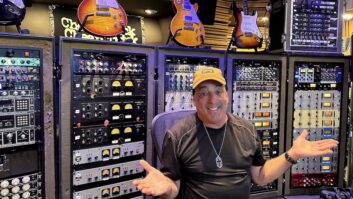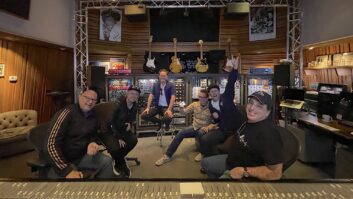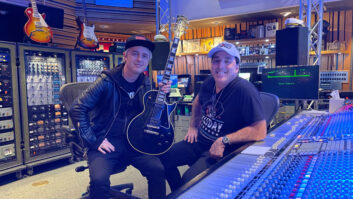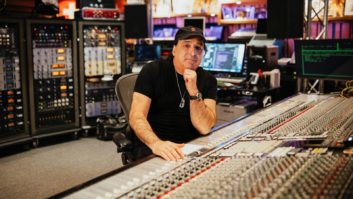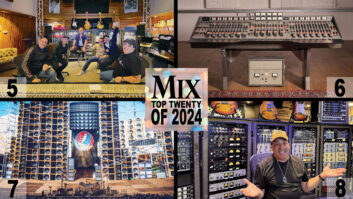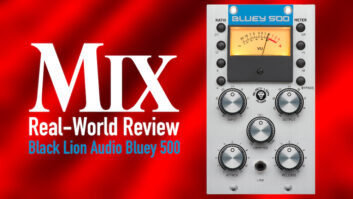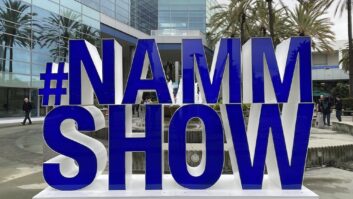You have to give everything its own identity for the artist. You can’t put your imprint on it.
I would rather compress a vocal hard to get some personality out. It’s like putting a snazzy jacket on a guy when he goes out at night — it adds attitude.
Living in Los Angeles for more than 15 years seems to have had very little effect on Chris Lord-Alge’s East Coast style. In case you haven’t met the guy, I have to tell you, this is one rapid-action dude. His hallmarks are speed and efficiency, and he is definitely not into wasting time — his or anybody else’s.
This elder scion of the Lord-Alge family started his career in his native New Jersey where he was a drummer in local clubs. Today, he is one of the most in-demand mixers around, and speculation about his formula for success runs rampant: How can he do it so fast and so often? That question becomes even more puzzling when you listen to a medley of his mixes, because, unlike the product of some other top mixers currently riding the charts, CLA’s mixes all sound different. While listening to Dave Matthews Band, Faith Hill and Melissa Etheridge, you’ll be hard pressed to recognize a CLA stamp.
Confident, opinionated, assertive (okay, aggressive!) and extremely verbal, CLA is also eager to please. Those attributes, along with his inherent musical and technical talents, have created a winning combination and garnered him a long string of hits and two Grammy nominations. Among his Platinum mix credits, Lord-Alge numbers Dave Matthews Band’s Everyday, Green Day’s Nimrod, Fastball’s All the Money Pain Can Buy and Savage Garden’s Savage Garden. He’s frequently brought in to pinch hit on radio mixes; you’ve heard his work on singles by No Doubt, Everclear, Orgy, Barenaked Ladies, Nine Days and Foo Fighters, among others. Look a little further back in his discography and you’ll find some other interesting artists: Collective Soul, Hole, Bad Religion, Meredith Brooks, Joe Cocker, Chris Isaak, Sprung Monkey and B.B. King, to name a few.
So how does he do it? I sat down with him one morning at his longtime home base studio in Hollywood, hoping to find out. Day after day, he cranks out the hits there, working on a 60-input SSL 4000 G Plus console in a control room that he has perfectly configured to accommodate his taste. It was a Saturday, around 11 a.m. when I dropped in, and he’d already been working on some P.O.D. remixes for a couple of hours.
So, what time do you usually come in to work?
Well, I leave my house, which is 35 or 40 minutes away, at a quarter to nine.
Mix well, go home early.
Well, we try to get out of here at a reasonable hour. We only work late if we have to. If you do this six, seven days a week, you’ve got to have balance. I worked 12 hours a day when I was starting out, and I still do it if it’s necessary, but it’s usually not. That’s better for everybody. I really don’t want people to go out to dinner and then come back here afterward and try to concentrate when they’re tired. I just try to make it easy. I find that my clients like it better that way.
Why do you think people come to you to do a mix?
I think record companies look at mixers like baseball players. If they’re going to put somebody in to pinch hit, they’d better hit a home run. They don’t want to take any chances anymore; you’ve got to make their song happen. And if, time and again, you’re turning in exactly what they want, they’re going to come back to you. You can’t have them call and say, “Well, I’m not sure about that.” Because then you’re not going to get hired the next time.
Yeah, but how does one do that?
I guess you just have the ear and the creative talent to pull it together. A big part of it is having the kind of mentality that knows it’s not your song. You’re making it for the clients and for the people who are going to buy it. If a record you’re mixing is for 17- to 21-year-olds, whether it’s edgy rock or more hip hop-oriented, you better make sure that’s who you’re aiming for. Of course, you have to like it; you’re mixing it! You make it to where you like it, and you hope that when you like it, they all like it.
Now, I don’t mean that all this is easy. It takes years to refine your tools and your talent to make it work for every type of music. But my work ethic is a strict routine — how I work my guys, how I work — that I don’t waste any time. I’m not sitting around watching TV or taking a long lunch. I just go in there and get it. There’s plenty of time to eat, drink and be merry later, off hours. Socializing with the clients is one thing; you’ve got to make them feel at home. But generally, the clients I work with want to come in here, do a little refining, get a CD and run for the door. They think it’s great that when I say it’s ready at four, it’s ready at four.
You frequently get hired to mix singles for the radio. What’s different about doing that vs. mixing for an album?
You look at the album version, figure out what you think is, in your personal opinion, going to make it better and you take it to the next level. It’s very competitive out there.
Are you friendly with many radio programmers?
Yeah, I know some programmers at the key stations in town. I know what their equipment does sonically to the record, I know what they’re playing and what kind of song makes them jump, based on form or length or style. So I generally have a good idea if a song has even got a shot, and what’s going to make it have a shot. Remember, people don’t have any patience on the radio. If they don’t get it in like 20 seconds, they’re switching stations.
You’ve mentioned your concern that people may not hear the radio version when they buy an album.
Personally, I think when you’re mixing an album, you want to maximize every song. Whatever they thought was not a single, you try to make into a single.
By editing? Changing arrangements?
A lot of the time, it’s just how you make it sound. You make it as competitive as possible. Then, if the thing is clocking in at 5½ minutes, you say, “Hey, by the way, I can pull a 3:30- or a 4-minute out of this for radio play.” Half the time, they’ll decide to use that version on the album.
You trim the fat. I know you guys like it long, you want it six minutes. But if your album is 70 minutes long on the CD, I think that’s overkill. I can get the first four Beatles albums on one CD — that’s how short they were. Length is important. Make people want to listen to it again! Twenty choruses at the end is just going to make them not want to ever hear it again.
Is it still a part of your technique to bounce tracks to a 3348 and place them where you want them to come up on your console?
Absolutely. Pretty much everything comes in on Pro Tools, and I have my two crack assistants prep it the way I want it and transfer it.
Is that what you did with Dave Matthews Band’s latest?
That came in on 48; it was on Pro Tools, and they transferred it themselves. I asked for two copies of each song so that I could manipulate one and leave one existing. By manipulate, I just mean parking tracks where I want on the faders digitally, without having to cross-patch. Or comping vocals or other parts that I think should go together. Because, for me, the less faders you have to deal with, the better it sounds. You don’t need 90 faders to make it happen.
Do you listen to a rough mix before you start?
Generally, I don’t want to hear it until I mix it. If it’s what I call a “bug hunt,” and the rough mix contains mutes and arrangement issues that are not locked into their tape, then I need the rough mix to find out what’s going on. Even if I disagree with their arrangement, I’ll make their arrangement happen first, then I’ll have an alternate and say, “Here’s what I think is better.”
But with most of my clients, everything that’s on that tape I use; every morsel is eaten. And in that case, I don’t listen to their rough mix unless they are so married to it that I have to emulate it. Generally, I don’t want to have any concept. I don’t even want to know the song title. Put it up, here we go — completely fresh. If you asked me what song I mixed yesterday; I may not remember the exact song title, but I’ll always remember the hook and the vibe. That’s what’s important.
Because you’re so into speed and efficiency, I’m surprised you haven’t converted to hard drive random access.
It’s not recognized as a professional medium that can be archived. What are you going to do? [What if you] put the hard drive away in some vault, and in 10 years, when they want to resurrect that album, that software is not to be found, or it doesn’t work, or those files are corrupted? Yeah, that’s really helpful. The format is not nailed down as a stand-alone medium that will sit in storage, and right now the 48-track is.
But what about all that wasted rewind time?
You know what? I need the rewind time. You record on the 3348 at the right level, and you set it up so it hits the console at the optimum level, which is something you don’t generally see with Pro Tools. Pro Tools is a great recording and editing medium, and maybe at some point they’ll have an interface that works with every console and can be put away for archiving. Until then, I want it on a piece of tape.
There have been many times lately that I’ve been trying to remix a single and they can’t find the tape — because there is no tape. The guy with the Pro Tools file is nowhere to be found, and they don’t know who edited what. I’ll have to get all these different Pro Tools sessions to try to pull together one that makes sense for what they did in their final mix.
The truth is that a lot of guys who are doing it are making a mess of it. They don’t notate properly, they don’t archive properly, they don’t have it pulled together. A record company ends up scrambling to find this record that they paid a million dollars to make.
Until they come out with the ideal medium, I say stick with one that works. People are saying, “Well, it’s not 24-bit, it’s only 16-bit.” And I say, “If it sounds good, what do you care what the word length is?” Let the bits fall where they may. The system I use works, and it sounds good.
You’re known for your opinions on getting rock ‘n’ roll drum sounds.
Well, a drum kit is a kick, snare, toms and cymbals, but it’s really one instrument. So when you’re recording, of course you don’t want a lot of crap on the kick drum, and you don’t want tons of hi-hat in the snare, but you want to record it so that each mic complements the other. I’ll EQ the hi-hat track to sound like a snare drum to help the snare if I need to, because the hi-hat is going to come through everything anyway.
Also, there’s a disadvantage right off if you’re recording the drums to digital. If you record the drums analog, you can make a lot of mistakes, and they’re going to automatically sound like something because of what the analog tape does to it. You can’t get that out of any kind of digital. A really good engineer can record digital and get away with it; but if you’re still fishing around for the perfect drum sound, digital isn’t going to complement it.
Analog is like one of those low riders driving around with tinted windows; it’s got a vibe. You see through it, but not completely. There’s a little tint. Digital is like a clear pane of glass that, if you’re not looking, you’ll walk right into. It doesn’t do anything to the sound; if anything, it makes it worse, makes it more clinical. When I get records where I can’t stand the drum sound, where it just doesn’t feel right, I transfer it to analog and back just so I can bear listening to it. Because as a drummer, it’s got to feel right to me.
What compressors do you like on drums?
When drums are recorded, my preference is to try not to use any compression. Use the old Neve mic pre’s, use the good mics, try not to over-EQ and add as much bottom as you can, because the bottom is the thing that’s tough to get right. Try to make it so the mic pre’s aren’t clipping on the kick drum. Which happens all the time — can ya just listen to it, please? There’s nothing wrong with the drums being a little plain Jane. If you want to mangle a couple of tracks with these cool compressors at the studio you’re recording in, put them on a couple of extra tracks.
I’m not saying make the original drums boring — you try to go for something. Maybe the band’s into Led Zeppelin or that dry, old disco sound. Whatever. But try to do it so it makes sense, where you’ve got somewhere to go.
Sometimes I get drum tracks and they’re so mangled that there’s nowhere to go and I have to try to undo what they did. The rooms are distorted, or the snare is so compressed it’s just a little “ping.” I know you guys all want to experiment and try all these things, but try to leave some of it simple, straight-ahead, clear, because it’s a lot easier to mangle it later than to unmangle it. Compression can be dangerous in the wrong hands. It’s like a gun; once you shoot a hole in something, you can’t plug it.
Okay, say you’ve been given some nice, plain-Jane drum tracks.
On the kick and snare I’ll generally end up with some Manley EQs, and I go between Distressors and dbx 160s. A lot of times, the console compressor is perfect for the kick and the snare. Or I’ll tinker around between an 1176 or an old Neve compressor — one of the verticals that I have.
A lot of times, I won’t even touch the room tracks. If they’re uncompressed, it can be even better; I can just ride them. Overheads, if they’re kind of lackluster, an 1178 will put them right there.
When you’re compressing drums, it depends on how aggressive the song is. If you have two pounds of baloney in a one-pound bag, and there’s a wall of guitars competing with the drums, you’ve got to compress more and more to get the drums to stay punchy through the whole song. And if the snare drum isn’t too high and it has some depth to it, that gets a lot easier.
I hear you use an oddball pair of Pultecs across the mix bus.
They’re 1S3s, with consecutive serial numbers. They’re a different bandwidth (than EQP 1As.) So the whole mix goes through tubes. Tube low end really helps the overall picture; it makes it sound more musical.
Listen to the radio. These days, it’s all about the low end — getting it clear. Low end is the hardest thing to get right. High end is easy because everybody usually records so bright. And this console — old console that it is — has the sweetest-sounding high end. You crank the knob to the roof, and it’s just enough.
It looks like you have two of every piece of gear.
Yeah, it’s a little Noah’s ark action. You can’t go wrong with a pair of everything. Like Neve compressors. I’ve got these 22609s with 2254s built into them; they were from the 8058. The next ones over, from the 8068, are the orange cap 2264Xs. Then, from the 8078 I have the 32264As.
I pretty much have the whole history of the Neve compressor. I have the very first one here — the 2252. Then it went to these 2254s, these 2264Xs, and then they came up with the 33609. I have a Rev A with the metal knobs — the original Class-A ones, very rare. They remade it a few years later with the 33609 C — the Rev C — I have a modified one. I also have a pair of 1073s, in case I have to fix something.
For a diehard SSL guy, you sure know a lot about Neve gear.
Well yeah, I prefer projects that are recorded on old Neve consoles. Neve/SSL is the big complement.
What’s this rumor that you don’t like to change settings on your outboard gear?
It’s true. On the limiters, that is. Rather than change a setting, I’ll just buy another one and set it differently.
You’re putting me on.
No, that’s what I do. That’s why I have so many. I have that one set for a certain sound, this one set for a different sound. I just power them up, plug them in and they’re on the best setting. I change the EQs, but that’s it. The limiters stay set to the optimum setting for that limiter. It’s part of the gig; it helps the repeatability.
Okay, what’s that 1176 set for?
It’s a gain structure thing, really. Each 1176 that I have here has a different sound. This is fatty, this is skinny, and that one is for vocals that are too boomy. I can listen to the vocal for three words and say, “Okay, put number three on him.” Or number one, usually number one, my old blue, magical-sounding 1176 — the first ones they made. Basically, I could put covers on my gear for weeks, and not have to worry about it. I’d just say, “That one’s not right, plug in the next one. Okay, that’s better.”
There are certain limiters that just stay patched into certain spots of the console — been there for a long time. And they work great because I always put my tracks in the same place.
One of the most important things about mixing is having a routine. That may sound boring, but it works. I don’t want to think about where the kick drum is on the console, or where the vocal is. They’re always going to be in the same place, and I can worry about the song instead. Because it ain’t about the gear; it’s about the song. If you don’t do the song justice, you shouldn’t be mixing.
On my way over I was listening to songs you’d mixed for three different artists, and they all sounded completely different. I wouldn’t have guessed that they were all mixed by the same person.
You would think, from how I have it set up here, that every mix is going to sound the same, like cookie-cutter mixing. No. It’s just convenience. Just because tracks are parked in the same place on the console, and a lot of times are going through the same gear, doesn’t mean the music will sound the same. You have to give everything its own identity for the artist. You can’t put your imprint on it.
What is it you love about this [SSL 4000 G Plus] console so much?
Bottom line, this console has attitude. In 10 more years, these consoles will be like old Neves. They’re classic. This one was installed in about 1985; it’s modified as far as you can go, and it’s in great shape. And it’s got light meters, which I like. I’m all about the meters.
What do you mean?
I’ve got to see what’s going on. I don’t do this by ear only! I use the meters to balance things left and right, and to see what’s going on with each fader so I can optimize the console.
They’re set to show input?
No, the output of the fader — fader to mix — EQ’d and everything. It’s all about maximizing the signal strength. You hit the tape machine a certain way, the tape machine is hitting the console a certain way, you’re hitting the mix bus a certain way. You’re at the sweet spot. All consoles have a pretty small sweet spot where it really sounds good.
That’s something you don’t hear mentioned much lately.
Well, everybody’s thinking because they’re digital, they don’t have to worry about a sweet spot. Well, yeah, you do. Digital craps out so quick it’s disgusting. In an all-digital console, the sweet spot is tiny — like a postage stamp. But there’s a small window on any console where the headroom is right and where it really sounds the best. That’s where I stay, in that window.
So, shouldn’t SSL have called the new Classic console the Chris Lord-Alge “Special Edition”? You know, like a guitar.
Well, CLA is in Classic as it is. So they kind of did. Don’t get me wrong. There’s nothing wrong with new consoles. I’m not an old fogey saying I won’t change anything. But when I go into a car race, I want to be in a Ferrari with a shifter, a steering wheel and a gas pedal. I don’t want to have so many gauges that it deters me from winning. And I don’t want to be here all night trying to figure out the console or the automation.
The main function I like about the new digital consoles is that, if I have a mix done, and my client is late, I can start the next mix, have it in memory and pick up where I left off. But everything else hasn’t outweighed this desk yet. What I’d really like is another one of these consoles put back to back with this one. Just think: It’s cheaper, I can have mix number one here and mix number two here…If it was up to me, I would have this console hydraulically drop to the floor and have the other one come up — like A and B stages at a concert. Bottom line, I like the way this rig works, just give me another one.
I’m an SSL guy since day one, and I like the MT, but I think this whole digital thing is in flux. Who knows where it’s going to stop? To me, one big problem with a digital console is that this year it’s good, next year it’s not high enough resolution.
What format do you mix to?
Ampex half-inch 2-track, GP9 plus 6, and to 16-bit DATs with the Apogee PSX converter, and to CDs. I tried a couple of hard drive units, but I haven’t had much success with them. I’m sure there are some great units out there, but the one that I had, as soon as it started skipping on the hard drive I gave it back.
Let’s talk about vocals.
Vocals are the most important part of the track. And a lot of times they are not recorded as well as they could be, with the right limiter. You’d be surprised at how much compression you need to put on vocals to make them sit right in the track. Sure, you cannot compress it much and ride it, but it ain’t going to have the personality that good old compression is going to give it.
I would rather compress a vocal hard to get some personality out. It’s like putting a snazzy jacket on a guy when he goes out at night — it adds attitude. And nothing adds attitude more than 1176s. I have six to choose from. I also like Vac Racs, which you see I have eight channels of.
I’ve found that these tube Vac limiters are perfect for backgrounds, and a lot of times for rock records they’re perfect for the lead vocal. They only have one setting: both knobs all the way to the right. That’s the optimum setting.
My vocals are always in the 17-24 bucket, right in the middle, which is important because you also have to send them to a couple of faders to help the level. You don’t want the vocal faders to be up too high, where they start to clip and the console is not in that window. So, why not just bus the vocals to two more faders right next to them, just to help the level, and you send your overall effects from those faders.
I generally don’t put boatloads of reverb or chorusing on vocals; I just pan them left, right or center. If I have a song where all the backgrounds are mono tracks, I’ll pound them up the middle because that blend may work better. Or I may stereoize them with a little harmonizer. I use an old H3000, or I’ll use Early Reflection preset on a REV5 to make it a little stereo and not quite as dry-sounding.
The hardest thing to do is to get the vocal to sit right in the track. And then to de-ess them so they don’t sound like they have a lisp, but to keep the sibilance under control.
What de-essers do you use?
dbx 902s. But a lot of times if you pick the right compressor, it kind of de-esses by itself. The tube limiters, especially, knock the esses off pretty good.
What do you monitor on?
NS-10s with an Infinity subwoofer that I got at Frys for about 300 bucks.
A subwoofer?
You’ve gotta have a subwoofer; if you can’t hear what’s going on down there, you can’t get it right. I know, some guys mix with subwoofers, they have it too loud, and their mixes end up with no bottom. But if you set it just right so you can hear that lower octave, you’ll sometimes dig for the deeper notes. Especially if you are going to do anything that’s R&B- or rap- or hip hop-based, you’ve got to have the subwoofer so you can get the truck frequency. That low boom that all those guys in the trucks want to hear.
I also have my little Sony blaster. It’s rack-mounted, and that’s the comparison. My little brother Tommy turned me on to it, and every client who comes in here wants to hear their mixes on it. If it doesn’t sound good through 2-inch speakers on your little boom box, what’s the point? It’s got to sound big on a small speaker. You are trying to make something sound larger than life on the smallest medium possible.
Speaking of your little brother Tommy, when I did an interview with him a few years ago, he spent the first half-hour talking about you.
Well, I did train him! He used to work with me, and I’m glad he’s doing great.
On her latest CD, Stevie Nicks called you a “master craftsman.”
That was really nice. A lot of what we do is really crafting. Because sometimes you’ll get what’s kind of a mess without any real direction or arrangement — everybody playing the whole song. And you’ve got to weed it out. You try to maximize what they have, and a lot of the time, you’re just opening it up where there is too much going on right away.
I do it by instinct. Like a 12-inch; just arrange it, make it slim, make the chorus go bang! Usually, I just do it and the client comes in and goes, “Wow! I like it.” The vocal and the groove are standing out a little bit better now; the verses build, and it seems to go somewhere.
What’s your advice to someone who wants to get the most out of hiring you to do a mix?
Let the artist and the producer live with the recording, to make sure that they like the arrangement. You don’t want to go into the mixing room and say, “I don’t know about that keyboard, or that guitar, I don’t know about this or that.” As soon as you start going “I don’t know,” you are never going to get done. Indecision shouldn’t be in the mixing room. Let me make the record sound good; not try to weed through the arrangement. It’s one thing to make a short version or an edit, but if there are parts that you are unsure about, don’t even put them on there. Get rid of them. Make a decision.
You’re in a place to have a unique perspective of our industry and where it’s going. What do you see?
We’ve experimented with techniques and with sounds; I think that we’re going to get back to good songs. I would hope that we get more records with character, and not so much stuff that’s cookie-cutter. But, at the end of the day, it’s the housewife with a two-year-old, sitting in the kitchen with the radio on, or the guy driving his car at the beach with his girlfriend. A cool song comes on the radio, that’s all that matters.
Maureen Droney is Mix‘s L.A. editor.
Dave Matthews Band:
Everyday
Sugar Ray:
Sugar Ray (mixed five tracks)
Dido: “Don’t Think of Me” (radio mix)
American Hi-Fi: “Flavour of the Weak”
Faith Hill: “I Should Fall” and “Let’s Make Love” (off of Faith, 1998 Grammy nominee)
Nine Days: “If I Am” and “Absolutely (Story of a Girl)” (off The Madding Crowd)
Green Day:
Nimrod
P.O.D.:
Fundamental Elements of Southtown (six tracks)
Macy Gray: “I Try” (special retail mix)
Hole:
Celebrity Skin (mixed four tracks)
Fastball:
All the Money Pain Can Buy
Savage Garden:
Savage Garden
Everclear: “I Will Buy You a New Life” and “Father of Mine” (off So Much For the Afterglow)
